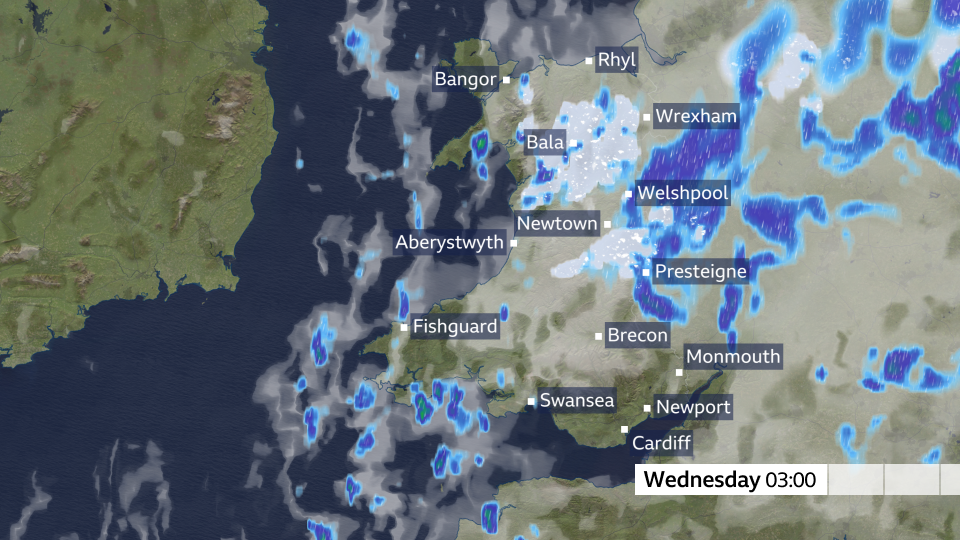Snow and ice warnings issued across Wales

Snow and ice yellow weather warnings have been issued across Wales
- Published
Snow and ice are expected across Wales this week, amid warnings for potential disruption and injury.
The Met Office has issued two yellow weather warnings for Wales: one for ice overnight on Tuesday into Wednesday morning, and another for snow and ice from midday on Wednesday until midnight on Thursday, mainly across the south-west.
Forecasters have cautioned that buses and trains may be cancelled or delayed due to the inclement weather, and advised planning ahead for car journeys and allowing more time.
Untreated pavements or cycle paths may become treacherous or impassable for those travelling on foot, and there is a slight chance of power cuts in more exposed areas, they warned.
Chance of snow in UK this week after Storm Claudia clears
- Attribution
- Published3 days ago
Ruined furniture dumped as town calls for better flood defences
- Published15 hours ago
Outbreaks of rain and freezing temperatures overnight on Tuesday could lead to widespread icy patches on Wednesday morning across much of the Wales.
The Met Office said most areas will see little, or no, lying snow, but warned any light snow in the hills is likely to turn to ice or slush.
Significant snow accumulations will be largely restricted to communities and transport routes above about 300m elevation.
Which areas are affected?
On Wednesday, the yellow ice warning covers:
Blaenau Gwent
Bridgend
Caerphilly
Cardiff
Carmarthenshire
Ceredigion
Conwy
Denbighshire
Flintshire
Gwynedd
Merthyr Tydfil
Monmouthshire
Neath Port Talbot
Newport
Pembrokeshire
Powys
Rhondda Cynon Taf
Swansea
Torfaen
Vale of Glamorgan
Wrexham
Pembrokeshire Dangler

A satellite image showing the "Pembrokeshire Dangler" down the coast of Wales
Meanwhile, wintry showers will feed southwards across south-west Wales through Wednesday and Thursday, moving inland on brisk northerly winds.
Small snow accumulations are possible in places, especially overnight and farther inland, with expectations of up to 5 cm - with about 10 cm forecast in some elevated spots in Pembrokeshire and west Carmarthenshire.
Gusty winds and hail may accompany some of the showers, and wet conditions and freezing temperature will, again, bring a risk of ice.
The Wednesday/Thursday warning covers the following regions:
• Carmarthenshire
• Ceredigion
• Pembrokeshire
• Swansea
BBC Wales meteorologist Derek Brockway said although the Pembrokeshire Dangler sounds amusing, it is "actually a real thing".
"It's a persistent narrow band of heavy showers over the Irish Sea which often sits or dangles over Pembrokeshire," Derek said.
"It forms with a cold, northerly wind blowing across the relatively warmer sea.
"The air converges, forcing it to rise, forming towering clouds and frequent heavy showers of rain, hail, sleet and snow with a risk of thunder.
"While locations under the dangler can get hammered, places nearby only 10 miles away remain dry.
"Pembrokeshire Danglers are most common during the autumn and winter and can last for a few hours or a few days.
"In winter, they have been known to dump as much as 20cm (8in) of snow in places."
Staying safe
"Plan to leave the house at least five minutes earlier than normal to reduce your risk of accidents, slips, and falls," weather pundits have advised, ahead of the inclement weather.
"If making a journey on foot, try to use pavements along main roads which are likely to be less slippery. Similarly, if cycling, try and stick to main roads which are more likely to have been treated."
It is also important to check on any elderly relatives or neighbours, offer to clear paths with salt - to limit slippery access points - and ask if they need any practical help with shopping or medical support.

Snow and ice yellow weather warnings have been issued across Wales for Wednesday
Driving in icy conditions
What winter essentials should be in your car?
The Met Office says it is safer not to drive in icy conditions but if you must make a journey, the key advice is to drive slowly, "accelerating, braking, steering and changing gear as smoothly as possible to reduce the risk of a skid".
"Using a higher gear may be more appropriate to help grip on packed ice."
It is also advisable to allow more time for your journey, check your tyres and screen wash, and pack warm clothing, food, drink, a blanket and a torch.